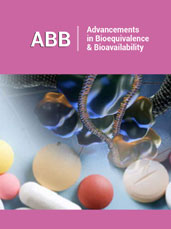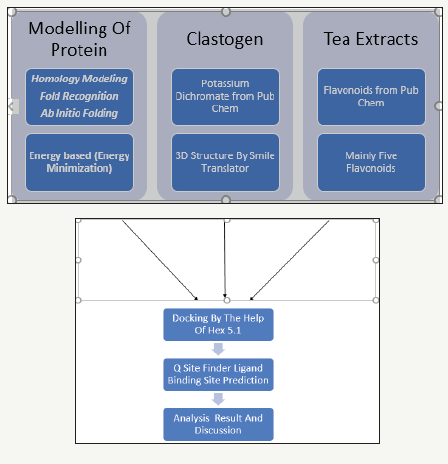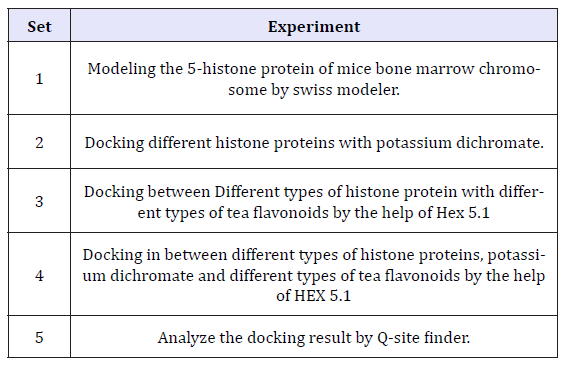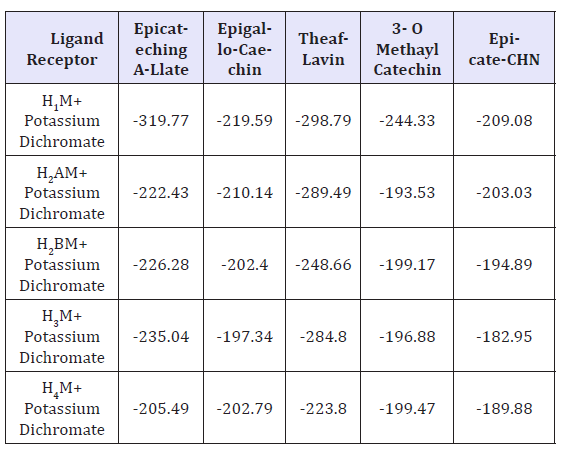- Submissions

Full Text
Advancements in Bioequivalence & Bioavailability
In Silico Study on Tea Flavanoids as Anticlastogens
Dhiman Chandra Paul, Minakshi Bhattacharjee and Manash Pratim Sarma*
Department of Biotechnology, Assam down town University, India
*Corresponding author: Manash Pratim Sarma, Associate Professor and HOD, I/C of Faculty of Sciences Department of Biotechnology, Assam down town University, Gandhi Nagar, Panikhaiti, Guwahati- 781026 India
Submission: June 11, 2018; Published: August 08, 2018

ISSN 2640-9275Volume1 Issue4
Abstract
The interaction of flavonoids of tea extract with different histone proteins member of bone marrow of Swiss mice in silico were satisfactory, and all the interaction (Docking using Hex 5.1) were found to have very low entropy values indicative of strong interaction. Potassium dichromate which has been reported in literature as a potential clastogen was also tested for its activities and interaction with histones and it was found that the interaction of compound also yielded very low E- values. Different histone proteins were docking with flavonoids of tea extract at very first step to give some values and histone proteins docking with flavonoids of tea extract in presence of known clastogen (potassium dichromate) gave some values. From the values the study could suggest the flavonoinds were midly anticathodes.
Keywords: Flavonoids of tea extract; Histone protein; Docking; Anticlastogenic effect
Introduction
Tea is one of the most popular beverages consumed which is drinking by human being around the world. Near about 75 percent has occupied by Black tea in whole world in case of world’s tea consumption. Black tea is the most common tea beverage consumed in United States, United Kingdom (UK), and Europe. In case of Japan and China they use mainly green tea consumption. Oolong and white tea are consumed in much lesser amounts around the world. It is made from the leaf of the plant Camellia sinensis. Shortly after harvesting, tea leaves begin to wilt and oxidize [1-13]. Chemicals in the leaves are broken down by enzymes by the process of oxidation, by this process leaves of tea are becoming darkening in color and the well-recognized aroma of tea. That enzymatic oxidation reaction can be stopped by the help of heat to inhibit the enzyme. Determination of tea’s type depends on the amount of oxidation of tea leaves Figure 1. When tea leaves are wilted, bruised, rolled, and fully oxidized causes formation of black tea. When tea leaves are not wilted and oxidized causes formation of green tea.
figure 1:

Tea consists of polyphenols, alkaloids, amino acids, carbohydrates, proteins, chlorophyll. The odor of tea produces by some volatile components. And few amounts of fluoride, aluminum, minerals, and trace elements are present in tea. In case of green tea, the catechins (epigallocatechin-3-gallate (EGCG).) which are polyphenols, a large group of plant chemicals are responsible for the health benefit.
Black tea contains much lower concentrations of these catechins than green tea [14]. The concentrations of thearubigins and theaflavins can be increased by more oxidation of black tea. Oolong tea contains a mixture of simple polyphenols, such as catechins, and complex polyphenols [15]. White and green tea contains similar amounts of epigallocatechin-3-gallate but different amounts of other polyphenols [16]. The polyphenol (EGCG, EGC, ECG, and EC) of green tea and the theaflavins and thearubigins in black tea shows the anti-oxidative nature which can prevent the clastogenic effect. These free radical of EGCG, EGC shows some activity and may protect cells from DNA damage caused by reactive oxygen species [17]. Inhibition of tumor cell proliferation as well as induce apoptosis has done by polyphenol compound of tea infusion in in-vitro and in-vivo conditions studies [18-23]. Inhibition of angiogenesis and tumor cell invasiveness has done by tea catechins in both studies in-vitro as well as in-vivo [24]. It can also protect the cell from damage by ultraviolet (UV) B radiation [25], and they may modulate immune system function. Detoxification enzymes, such as glutathione S-transferase and quinone reductase are activated by green tea which may help protect against tumor development [26].
Strong antioxidant activity of tea polyphenols, the precise mechanism by which tea might help prevent cancer has not been established [27]. The widespread consumption of tea throughout the world has stimulated interest in possibility of its use in chemoprevention of carcinogenesis and its related phenomenon, mutagenesis. Green tea is able to inhibit mutagenesis at concentration levels equivalent to daily human consumption. Green tea reduced the formation of skin cancers induced by UV light [28] lung cancer induced by asbestos. The property of anti-mutagenesis has been related to different components of the tea extract like isolated [29]. The black tea infusion is less definite, its anticancer property having been shown only against UV light-induced skin cancer [30]. Very little work has been carried out on the activity of black tea in preventing chromosome damage.
During the past decade it has emerged that the packaging of eukaryotic DNA by histone into chromatin is a key regulator of nuclear processes involving DNA, such as transcription and replication. Histones are highly alkaline proteins found in eukaryotic cell nuclei that helps the strand DNA into structural units called chromatin. They are chief protein components of chromatin acting as spools around which DNA winds. Without histone, the unwound DNA in chromosomes would be very long and that might create difficulty in duplication during cell division. So, histones are major component to Chromosome directly or indirectly (Table 1 & 2). The present experiment was undertaken to observe the effects of standard black tea infusion on mice bone marrow chromosomes (especially Histone proteins of DNA) in silico condition and its protective action against known clastogen like Potassium Dichromate.
Table 1:

Table 2: Experimental protocol.

Materials and Methods
Throughout the entire duration of the work many computational approaches have been used to obtain the ultimate results. For that we need some tools (Bioinformatics).
Results
E-Total value shows the docking result.
E-Total value shows the docking result.
Discussion
From the observed results it can be concluded that the interactions of the flavonoids of the tea extracts with the different histone protein members were satisfactory, and all the interactions were found to have very low entropy values indicative of a strong interaction (Table 3-5). Potassium dichromate which has been reported in literature as a potential clastogen was also tested for its activities and interactions with histones and it was found that the interactions of the compound also yielded very low E–values [31]. This observation goes a long way to help us understand a possible molecular mechanism of the various clastogens which have been reported in literature to cause chromosome damage.
Table 3: Docking between different types of histone protein and potassium dichromate by the help of hex 5.1

Table 4: Docking between different types of histone protein with different types of tea flavonoids by the help of hex 5.1.

Table 5: Docking in between different types of histone proteins, potassium dichromate and different types of tea flavonoids.

Interactions of potassium dichromate with the histones were also tested in presence of the bound flavonoids and it was found that the interacting pocket varied significantly with the condition where the former was made to interact with histones in absence of the flavonoids [32]. This observation leads us to conclude that the flavonoids serve as antagonist to the binding affinity of the clastogen and probably goes a long way in explaining the antimutagenic/anticlastogenic activity of the tea extracts. In vivo condition the previous experiment showed the satisfactory result by chromosome aberration of mice chromosome. We all know that the histone protein shows the important role on chromosome aberration for that reason I had done my experiment in silico with histone protein which showed the satisfactory result.
Conclusion
As we can predict from this experiment the tea flavonoids act as potent anticlastogenic So, that we can design synthetic compounds by the help of drug designing which will help in chemoprevention.) Because of clastogen agents like Potassium Dichromate the damage to DNA has been attributed to the generation of pre-oxygen radicals. The theaflavine-polyphenolic ingredients of black tea extract have shown to scavenge oxidative radicals and usually show strong affinity for proteins. So, we can use theaflavin as a drug and we can also synthesize the theaflavin artificially in laboratory.
References
- Mukherjee P, Sarkar D, Sharma A (1997) Effect of dietary consumption of black tea infusion alone and in combination with known clastogen on mouse bone marrow chromosomes in Vivo. Food Chem Toxicol 35(7): 657-661.
- Mukhtar H, Ahmad N (2000) Tea polyphenols: Prevention of cancer and optimizing health. Am J Clin Nutr (6 Suppl): 1698S-1702S.
- Wu AH, Yu MC (2006) Tea, hormone-related cancers and endogenous hormone levels. Mol Nutr Food Res 50(2): 160-169.
- Henning SM, Niu Y, Lee NH, Thames GD, Minutti RR, et al. (2004) Bioavailability and antioxidant activity of tea flavanols after consumption of green tea, black tea, or a green tea extract supplement. Am J Clin Nutr 80(6): 1558-1564.
- Seeram NP, Henning SM, Niu Y, Lee R, Scheuller HS, et al. (2006) Catechin and caffeine content of green tea dietary supplements and correlation with antioxidant capacity. J Agric Food Chem 54(5): 1599-1603.
- Lambert JD, Yang CS (2003) Mechanisms of cancer prevention by tea constituents J Nutr 133(10): 3262S-3267S.
- Zaveri NT (2006) Green tea and its polyphenolic catechins: Medicinal uses in cancer and noncancer applications. Life Sci 78(18): 2073-2080.
- Elmets CA, Singh D, Tubesing K, Matsui M, Katiyar S, et al. (2001) Cutaneous photoprotection from ultraviolet injury by green tea polyphenols. J Am Acad Dermatol 44(3): 425-432.
- Steele VE, Kelloff GJ, Balentine D, Boone CW, Mehta R, et al. (2000) Comparative chemo preventive mechanisms of green tea, black tea and selected polyphenol extracts measured by in vitro bioassays. Carcinogenesis 21(1): 63-67.
- Scalbert A, Williamson G (2000) Dietary intake and bioavailability of polyphenols. J Nutr 130(8S Suppl): 2073S-85S.
- Di Carlo G, Mascolo N, Izzo AA, Capasso F (1999) Flavonoids: old and new aspects of a class of natural therapeutic drugs. Life Sci 65(4): 337- 353.
- Ba Abbas A, Clifford MN, Walkar R, Ioannides C (1994) Marked antimutagenic potential of aqueous green tea extracts: mechanism of action. Mutagenesis 9(4): 325-351.
- Harter HL (1960) Critical values for Duncan’s new multiple range test Biometrics. International Biometric Society 16(4): 671-685.
- Imanishi H, Sasaki YF, Otha T, Watanabe M, Kato T, et al. (1991) Tea tannin component modify the induction of sister chromatid exchanges and chromosome aberrations in mutagen-treated cultured mammalian cells and mice. Mutat Res 259(1): 79-87.
- Luo SQ, Lix XZ, Wang CJ (1995) Inhibitory effect of green tea extract on the carcinogenesis induced by asbestos plus benz(a)pyrene in rat. Biomedical and Environmental Sciences 8(1): 54-58.
- Mukhtar H, Katiyar SK, Agarwal R (1994) Cancer chemoprevention by green tea components. Adv Exp Med Biol 354: 123-134.
- Rice Evans CA, Miller NJ, Bolwell PG, Bramley PM, Fridham JB (1995) The relative anti-oxidant activities of plant-derived polyphenolic flavonoids. Free Radical Research 22(4): 375-388.
- Sasaki YF, Yamada H, Shimoi K, Kator K, Kinae N (1993) The clastogensuppressing effect of green tea, Po-lei tea and rooibos tea in CHO cells and Mice. Mutation Research 286(2): 221-232.
- Shiraki M, Hara Y, Osawa T, Kumon H, Nakayama T, et al. (1994) Antioxidative and antimutagenic effect of theaflavines from black tea. Mutation Research 323: 29-34.
- Acker SA, Van Balen GP, Van den Berg DJ, Bast A, Van der Vijgh WJ (1998) Influence of iron chelation on the antioxidant activity of flavonoids. Biochem. Pharmacol 56: 935-943.
- Amarowicz R, Shahidi F (1995) Antioxidant activity of green tea catechins in a β-carotene-linoleate model system. J. Food Lipids 2: 47-56.
- Amarowicz R, Shahidi F, Presence of two forms of methylated (-)-epigallocatechin-3-gallate in green tea. Nahrung, 2003, 47(1): 21-23.
- Baatout S, Jacquet P, Derradji H, Ooms D, Michaux A, et al. (2004) Study of the combined effect of X-irradiation and epigallocatechin-gallate (a tea component) on the growth inhibition and induction of apoptosis in human cancer cell lines. Oncol Rep12(1): 159-167.
- Banerjee S, Manna S, Saha P, Kr Panda C, Das S (2005) Black tea polyphenols suppress cell proliferation and induce apoptosis during benzo(a)pyrene-induced lung carcinogenesis. Eur J Cancer Prev 215- 221.
- Borska S, Gebarowska E, Wysocka T, Drag Zalesinska M, Zabel M (2003) Induction of apoptosis by EGCG in selected tumour cell lines in vitro. Folia Histochem Cytobiol 41(4): 229-232.
- Chen ZY, Chan PT, Ma HM, Fung KP, Wang J (1996) Antioxidative effect of ethanol tea extracts on oxidation of canola oil. J Am Oil Chem Soc 73(3): 375-380.
- Chung HY, Yokozawa T, Soung DY, Kye IS, No JK, et al. (1998) Peroxynitritescavenging activity of green tea tannin. J Agric Food Chem 46(11): 4484- 4486.
- Chyu KY, Babbidge SM, Zhao X, Dandillaya R, Rietveld AG, et al. (2004) Differential effects of green tea-derived catechin on developing versus established atherosclerosis in apolipoprotein E-null mice. Circulation 109(20): 2448-2453.
- Fujiki H, Saganuma M, Okabe S, Sueoka N, KomoriA, et al. (1998) Cancer inhibition by green tea. Mutat Res 402(2): 307-310.
- Fujita Y, Yamane T, Tanaka M, Kuwata K, Okuzumi J, et al. (1989) Inhibitory effect of (-)-epigallocatechin gallate on carcinogesis with N-ethyl- N’-nitro N-nitrosoguanidine in mouse duodenum. J Jap J Cancer Res 80(6): 503-505.
- Jankun J, Selman SH, Swiercz R, Skrzypczak Jankun E (1997) Why drinking green tea could prevent cancer. Nature 387: 561.
- Kim M, Masuda M (1997) Cancer chemoprevention by green tea polyphenols in: Yamamoto T, Juneja LR, Chu DC, Kim M (Eds.), Chemistry and Applications of Green Tea. CRC, New York, USA, pp. 61-73.
© 2018 Manash Pratim Sarma. This is an open access article distributed under the terms of the Creative Commons Attribution License , which permits unrestricted use, distribution, and build upon your work non-commercially.
 a Creative Commons Attribution 4.0 International License. Based on a work at www.crimsonpublishers.com.
Best viewed in
a Creative Commons Attribution 4.0 International License. Based on a work at www.crimsonpublishers.com.
Best viewed in 







.jpg)






























 Editorial Board Registrations
Editorial Board Registrations Submit your Article
Submit your Article Refer a Friend
Refer a Friend Advertise With Us
Advertise With Us
.jpg)






.jpg)














.bmp)
.jpg)
.png)
.jpg)










.jpg)






.png)

.png)



.png)






